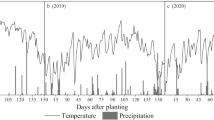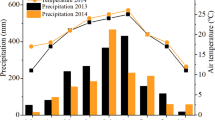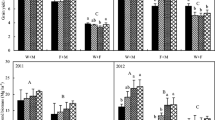Abstract
Field experiments were conducted at the National Agrobiology Research Center of the Brazilian Agricultural Research Corporation (Embrapa Agrobiologia) in Seropédica, Rio de Janeiro State, Brazil, from 1995 to 1998. Maize (Zea mays L. cv. BR 106) was intercropped either with cowpea (Vigna unguiculata (L.) Walp. cv. CNC 0434) or with jack bean (Canavalia ensiformis (L.) DC.) by planting two rows of these pulses for each row of maize. At the flowering stage of maize, the pulses’ shoots were used as green manure for the maize crop. Three levels of green manure were applied: zero, one, or two rows for each row of maize, either incorporated into the soil or left as mulch cover. The applied nitrogen was mineralized and taken up quickly by the maize crop. Only 7 days after green manure application, a significantly (p < 0.01) higher N content of maize leaves was determined in treatments with double-row application of green manure and its incorporation into the soil. Cowpea as well as jack bean shoot mass increased maize yield significantly (p < 0.01) after double-row green manuring. Positive N balances were achieved only by treatments with harvest residues of jack bean, i.e., treatments with jack bean grain production. In the course of the experiment, soil organic matter (SOM) of the upper soil layers (0–20 and 20–40 cm) increased significantly (p < 0.01 and p < 0.001, respectively) in intercropping treatments. In general, resources were used more efficiently by intercropping treatments: The land equivalent ratios (LER) of intercropping treatments without utilizing the pulses as green manure were significantly (p < 0.05) higher than “1”. The utilization of intercropped pulses as green manure offered the opportunity of a quickly available nitrogen source for the maize crop. At the same time, these treatments caused a deficient N balance because the utilization of pulses as green manure alone could not make up for N exports via harvest products.










Similar content being viewed by others
Notes
“fazendinha” means small farm or smallholding in Portuguese.
During the first and second experimental periods, cowpea was used as pulse component. Cowpea was replaced with jack bean in the third experimental period because two species of beetles, Cerotoma arcuata and Diabrotica especiosa, seriously attacked the cowpea causing loss of leaf area and damage to root nodules. Jack bean was not affected by these beetles.
The rates of BNF and the amounts of nitrogen derived from atmosphere (Ndfa) applied via green manure are presented in Table 5 as results of laboratory analysis.
Based on Pule-Meulenberg et al. (2010), the B value of cowpea was assumed to be −1.759. The one of jack bean was assumed to be −2.
The ANOVA according to John and Quenouille (1977) takes the so-called dummy comparisons into consideration when calculating the F value. In the present work, the comparison of M/0 (mulching of zero rows of green manure) and I/0 (incorporation of zero rows of green manure) was considered a dummy comparison because these treatments were identical. Differences of these treatments were only by chance.
References
Agboola AA, Fayemi AA (1971) Preliminary trials on the intercropping of maize with different tropical legumes in Western Nigeria. J Agric Sci 77:219–225
Almeida DL, Guerra JGM, Ribeiro RLD (2003) Sistema integrado de produção agroecológica: uma experiência de pesquisa em agricultura orgânica. Documentos, 169. EMBRAPA, Seropédica
Altieri MA (1999) Applying agroecology to enhance the productivity of peasant farming systems in Latin America. Environ Dev Sustain 1:197–217
Altieri MA, Nicholls CI (2002) Establishing an agroecological research agenda for family farmers in Brazil. Eisforia 1(1):8–36
Alves BJR, Boddey RM, Urquiaga SS (1993) A rapid sensitive flow injection technique for the analysis of ammonium in soil extracts. Commun Soil Sci Plant Anal 24:277–284
Boddey RM (1987) Methods for quantification of nitrogen fixation associated with gramineae. Crit Rev Plant Sci 6(3):209–266
Campanhola C, Valarini PJ (2001) A agricultura orgânica e seu potencial para o pequeno agricultor. Cadernos de Ciência Tecnol 18(3):69–101
Carsky RJ (1989) Estimating availability of nitrogen from green manure to subsequent maize crops using a buried bag technique. Ph.D. thesis, Cornell University, Ithaca, N.Y.
Cavalcante ES, Atroch AL (1995) Cultivares de Feijao Caupi (Vigna unguiculata (L.) WALP) recommendadas para o Amapa. Embrapa-CPAF/ Amapá. Comunicado Técnico 10(out/95):1–3
Dahmardeh M, Ghanbari A, Syahsar BA, Ramrodi M (2010) The role of intercropping maize (Zea mays L.) and cowpea (Vigna unguiculata L.) on yield and soil chemical properties. Afr J Agric Res 5(8):631–636
Eaglesham ARJ, Ayanaba A, Ranga Rao V, Eskew DL (1981) Improving the nitrogen nutrition of maize by intercropping with cowpea. Soil Biol Biochem 13:169–171
Empresa Brasileira de Pesquisa Agropecuaria (1979) Manual de métodos de análise de solo. Serviço nacional de Levantamento e Conservação de Solos, Rio de Janeiro
Franzluebbers K, Juo AS, Mann A (1994) Decomposition of cowpea and millet amendments to a sandy Alfisol in Niger. Plant Soil 167(2):255–265
Harrell FE, Dupont C (2014) Hmisc: Harrell miscellaneous. R package version 3.14-0. http://CRAN.R-project.org/package=Hmisc
Haynes RJ, Martin RJ, Goh KM (1993) Nitrogen fixation, accumulation of soil nitrogen and nitrogen balance for some field-grown legume crops. Field Crop Res 35:85–92
Heinzmann F (1981) Assimilation von Luftstickstoff durch verschieden Leguminosenarten und dessen Verwertung durch Getreidenachfrüchte, Dissertation Stuttgart-Hohenheim
Hungria M, Araújo RS (1994) Manual de métodos empregados em estudos de microbiologia agrícola. EMBRAPA, Brasília
Ibanez F, Grosjean P, Etienne M (2013) pastecs: package for analysis of space-time ecological series. R package version 1.3–15. http://CRAN.R-project.org/package=pastecs
Jeranyama P, Hesterman OB, Waddington SR, Harwood RR, Richard R (2000) Relay-intercropping of sunnhemp and cowpea into a smallholder maize system in Zimbabwe. Agron J 92:239–244
John JA, Quenouille MH (1977) Experiments: design and analysis. Charles Griffin, London
Köpke U (1993) Nährstoffmanagement durch acker- und pflanzenbauliche Maßnahmen. In: BMELF (ed) 5. Colloquium zur Bodennutzung und Bodenfruchtbarkeit. Berichte über Landwirtschaft 71(207):181–203
Kotschi J (2008) More ecology—less hunger? In: Ulrich Köpke (ed) Organic agriculture in the tropics and subtropics. ISOFAR Tropical Series, pp 171–176
Kumwenda JDT, Waddington SR, Snapp SS, Jones SRB, Blackie MJ (1996) Soil fertility management research for the maize cropping systems of smallholders in southern Africa: a review. NRG Paper 96-02. CIMMYT, Mexico, D.F.
Meng E, Ekboir J (2000) Current and future trend in maize production and trade. CYMMIT World Maize Fact Trends 2000:1–10
Neves MCP, Rumjanek NG (1996) Ecologia do Rizóbio em Solos Tropicais. Documentos, 23. EMBRAPA-CNPAB, Seropedica
Neves MCP, Espindola JAA, Guerra JGM, De-Polli H (2008) Optimizing the use of BNF in organic agriculture—advantages of the tropics. In: Ulrich Köpke (ed) Organic agriculture in the tropics and subtropics. ISOFAR Tropical Series, 1–16
Ofori F, Stern WR (1987) Cereal-legume intercropping systems. Adv Agron 41:41–90
Paffrath A, Leisen E, Puffert M, Lippert F (2003) Anbau von Feldgemüse. In: Dokumentation 10 Jahre Leitbetriebe Ökologischer Landbau in Nordrhein-Westfalen. Schriftenreihe des Lehr- und Forschungsschwerpunktes „Umweltverträgliche und Standortgerechte Landwirtschaft“Nr. 105, 113–126. Landwirtschaftliche Fakultät der Rheinischen Friedrich-Wilhelms-Universität Bonn
Pandey RK, Pendleton JW (1986) Soybeans as green manure in a maize intercropping system. Exp Agric 22(2):179–185
Peter G, Runge-Metzger A (1994) Monocropping, intercropping or crop rotation? An economic case study from the West African Guinea savannah with special reference to risk. Agric Syst 45(2):123–143
Pretty J, Hine R (2000) Feeding the world with sustainable agriculture: a summary of new evidence. SAFE-World Research Project, University of Essex
Pule-Meulenberg F, Belane AK, Krasova-Wade T, Dakora FD (2010) Symbiotic functioning and bradyrhizobial biodiversity of cowpea (Vigna unguiculata L. Walp.) in Africa. BMC Microbiology 10:89–98
R Core Team (2014) R: a language and environment for statistical computing. R Foundation for Statistical Computing, Vienna. URL http://www.R-project.org/
Rao MR, Morgado LB (1984) A review of maize-beans and maize-cowpea intercrop systems in the semiarid Northeast Brazil. Pesq agropec Bras 19:179–192
Reuter DJ (1986) Temperate and subtropical crops. In: Reuter DJ, Robinson JB (eds) Plant analysis: an interpretation manual. Inkata, Melbourne, pp 38–99
Schmidt, H (1997) Viehlose Fruchtfolge im Ökologischen Landbau - Auswirkungen systemeigener und systemfremder Stickstoffquellen auf Prozesse im Boden und die Entwicklung der Feldfrüchte. Dissertation, Fachbereich Landwirtschaft, internationale Agrarentwicklung und ökologische Umweltsicherung, Universität Gesamthochschule Kassel
Schulz B (1994) Ökologischer Landbau im Südosten Brasiliens: Vergleichende Analyse vier verschiedener Anbausysteme. Selbstverlag des Verbands der Tropenlandwirte, Witzenhausen
Schulz-Marquardt J, Weber, M (1993) Streifenanbau von Sommerweizen: Eine Möglichkeit zur Erzeugung von Qualitätsbackweizen? In: Landwirtschaftliche Fakultät der Universität Bonn (ed) Forschungsbericht Nr. 7 zur 7. Wissenschaftliche Fachtagung “Elemente des Organischen Landbaus” des Lehr- und Forschungsschwerpunktes “Umweltverträgliche und standortgerechte Landwirtschaft” der Landwirtschaftlichen Fakultät der Universität Bonn, 6.5.1993. pp 3–4
Schulz-Marquardt J, Weber M, Köpke U (1994) Anbau von Grünbrachestreifen im Wechsel mit Sommerweizen zur Erzeugung von Qualitäts-Backweizen. In: VDLUFA—Vereinigung Deutscher Landwirtschaftlicher Untersuchungs- und Forschungsanstalten (ed) Vorträge zum Generalthema „Alternativen in der Flächennutzung, der Erzeugung und Verwertung landwirtschaftlicher Produkte“. Kongreßband 1994, VDLUFA-Schriftenreihe, Jena, pp 549–552
Schulz-Marquardt J, Weber M, Köpke U (1995) Streifenanbau von Sommerweizen im Wechsel mit Futterleguminosen zur Erzeugung von Qualitäts-Backweizen im Organischen Landbau. In: SÖL und Fachgebiet Ökologischer Landbau der Universität Kiel (ed) Tagungsband 3. Wissenschaftliche Fachtagung zum Ökologischen Landbau, 21.-23.2.1995. Wissenschaftlicher Fachverlag, Gießen, pp 109–112
Svotwa E, Baipai R, Gwatibaya S, Tsvere M, Jiyane J (2008) Socieconomic trends and constraints in organic farming in the small holder farming sector of Zimbabwe. J Sustain Dev Africa 10(1):214–228
Thönnissen C, Midmore DJ, Ladha JK, Olk DC, Schmidhalter U (2000) Legume decomposition and nitrogen release when applied as green manures to tropical vegetable production systems. Agron J 92:253–260
Trani PE (1983) Análise foliar: amostragem e interpretacao. Fundacao Cargil, Campinas
Treichel M (2010) Milho doce é alternativa para os agricultores familiares. Gazeta do Sul, 12.06.2010, p 6
Unkovich MJ, Pate JS, Sanford P (1993) Preparation of plant samples for high precision nitrogen isotope ratio analysis. Commun Soil Sci Plant Anal 24:2093–2106
Vandermeer JH (1992) The ecology of intercropping. Cambridge University Press, Cambridge
Vesterager JM, Nielsen NE, Hogh-Jensen H (2007) Nitrogen budgets in crop sequences with or without phosphorus-fertilised cowpea in the maize-based cropping systems of semi-arid eastern Africa. Afr J Agric Res 2(6):261–268
Weber M, Schulz-Marquardt J, Köpke U (1994) Grünbrachestreifen im Wechsel mit Sommerweizen im Organischen Landbau. In: VDLUFA—Vereinigung deutscher landwirtschaftlicher Untersuchungs- und Forschungsanstalten (ed) Vorträge zum Generalthema “Alternativen in der Flächennutzung, der Erzeugung und Verwertung landwirtschaftlicher Produkte”. Kongressband 1994, VDLUFA-Schriftenreihe, Jena, pp 139–142
Wickham H (2007) Reshaping data with the reshape package. J Stat Softw 21(12):1–20
Wickham H (2009) ggplot2: elegant graphics for data analysis. Springer, New York
Wilcox RR, Schönbrodt FD (2014) The WRS package for robust statistics in R (version 0.24). Retrieved from http://r-forge.r-project.org/projects/wrs/
Willey RW (1979) Intercropping. Its importance and research needs. Part 1. Competition and yield advantages. Field Crop Abs 32(1):1–10
Willey RW, Osiru DSO (1972) Studies on mixtures of maize and beans (Phaseolis vulgaris) with particular reference to plant population. J Agric Sci 79:519–529
World Bank (2007) World development report (2008) agriculture for development. The World Bank, Washington
Wortmann CS, McIntyre BD, Kaizzi CK (2000) Annual soil improving legumes: agronomic effectiveness, nutrient uptake, nitrogen fixation and water use. Field Crops Res 68(1):75–78
Yamada T (1996) Adubacao nitrogenada do milho. Inf Agronomic 74(1):1–5
Zake J, Nagawa F, Walaga C, De Jager A (2002) Monitoring nutrient flows, nutrient balances and economic indicators of smallholder farms in Lukwanga Parish, Wakiso sub county, Wakiso district. Baseline Survey Report, July–December 2002. Agricultural Economics Research Institute (LEI), The Hague
Conflict of interest
Marco Hödtke, Dejair Lopes de Almeida, and Ulrich Köpke declare that they have no conflict of interests.
Author information
Authors and Affiliations
Corresponding author
Rights and permissions
About this article
Cite this article
Hödtke, M., Lopes de Almeida, D. & Köpke, U. Intercropping of maize and pulses: an evaluation of organic cropping systems. Org. Agr. 6, 1–17 (2016). https://doi.org/10.1007/s13165-015-0108-4
Received:
Accepted:
Published:
Issue Date:
DOI: https://doi.org/10.1007/s13165-015-0108-4




